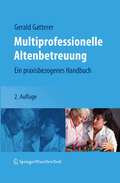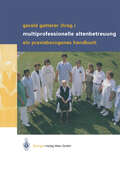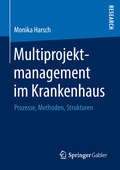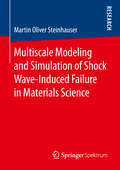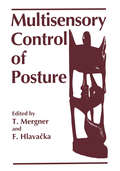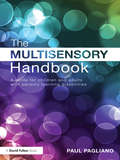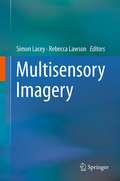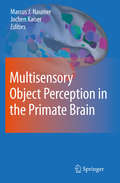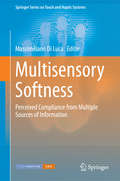- Table View
- List View
Multiplex Biomarker Techniques: Methods and Applications (Methods in Molecular Biology #1546)
by Paul C. GuestThis detailed book arrives as there is an increasing need for multiplex biomarker readouts for improved clinical management and to support the development of new drugs by pharmaceutical companies, due to continuous technical developments and new insights into the high complexity of many diseases. Chapters explore the basic technology platforms being applied in the fields of genomics, proteomics, transcriptomics, metabolomics, and imaging, which are currently the methods of choice in multiplex biomarker research. The book also describes the chief medical areas in which the greatest progress has been made and highlight areas where further resources are required. Written for the highly successful Methods in Molecular Biology series, methodology chapters include introductions to their respective topics, lists of the necessary materials and reagents, step-by-step, readily reproducible laboratory protocols, and tips on troubleshooting and avoiding known pitfalls. Multiplex Biomarker Techniques: Methods and Applications serves as an ideal resource for a wide variety of researchers interested in these vital multiplex techniques.
Multiplex Biomarker Techniques: Methods and Applications for COVID-19 Disease Diagnosis and Risk Stratification (Methods in Molecular Biology #2511)
by Paul C. GuestThis detailed volume explores the application of multiplex biomarker methods in the critical area of COVID-19 research through state-of-the-art technologies in the fields of genomics, proteomics, transcriptomics, metabolomics, and imaging. The book features a series of protocols from labs across the globe employing multiplex molecular approaches, which can be applied to accelerate progress in the research of SARS-CoV-2 and other infectious illnesses. Written for the highly successful Methods in Molecular Biology series, chapters include introductions to their respective topics, lists of the necessary materials and reagents, step-by-step, readily reproducible laboratory protocols, and tips on troubleshooting and avoiding known pitfalls. Authoritative and essential, Multiplex Biomarker Techniques: Methods and Applications for COVID-19 Disease Diagnosis and Risk Stratification serves as a vital resource for researchers in the areas of virology, metabolic diseases, respiratory disorders, as well as to clinical scientists, physicians, pharmacologists, and the healthcare services.
The Multiplication of Viruses / Virus Inclusions in Plant Cells / Virus Inclusions in Insect Cells / Antibiotika Erzeugende Virus-ähnliche Faktoren in Bakterien (Protoplasmatologia Cell Biology Monographs #4 / 3,4a,4b,5)
by Salvador E. Luria Kenneth M. Smith Pierre FredericqMultiprofessionelle Altenbetreuung: Ein praxisbezogenes Handbuch
by Gerald GattererDie Altenbetreuung wird in diesem Handbuch aus der Sicht von unterschiedlichen Fachdisziplinen umfassend vorgestellt. Namhafte Fachleute aus den Bereichen der Altenpflege, Medizin, Psychologie und Therapie sowie Angehörige bzw. Selbsthilfegruppen berichten über praxisbezogene Maßnahmen zur Lösung von leichteren bis schwerwiegenden Problemen, die mit dem Älterwerden verbunden sind. Die Themenkreise spannen sich von stationären und ambulanten Versorgungsstrukturen, Diagnostik und Therapie psychischer Erkrankungen im Alter, bis hin zu Rehabilitation, Kommunikation, Psychotherapie, Palliativmedizin und alternativen Betreuungsformen. Die zweite Auflage wurde durch ein Kapitel zu den Organisationsstrukturen der Altenbetreuung in Deutschland, Österreich und der Schweiz ergänzt. Alle Kapitel wurden neu strukturiert und überarbeitet. Dieses Buch gibt allen professionellen Helfern der Altenpflege sowie Angehörigen einen praxisrelevanten Überblick zur Betreuung und Versorgung von älteren Menschen.
Multiprofessionelle Altenbetreuung: Ein praxisbezogenes Handbuch
by Gerald GattererPraxisbezogener Überblick für professionelle Helfer und Angehörige. Die Themen reichen von stationären und ambulanten Versorgungsstrukturen über psychische Erkrankungen bis hin zu Palliativmedizin und alternativen Betreuungsformen.
Multiprojektmanagement im Krankenhaus: Prozesse, Methoden, Strukturen
by Monika HarschDas Multiprojektmanagement als übergeordneter Rahmen beinhaltet neben der erfolgreichen Durchführung von Einzelprojekten die Planung, Kontrolle und Steuerung einer gesamten Projektlandschaft auch die nachhaltige Etablierung – unterstützt durch den Aufbau von organisationalen Kompetenzen. Monika Harsch erläutert eine umfassende krankenhausspezifische Konzeption eines Multiprojektmanagements. Dafür nutzt sie bereits bestehende wissenschaftlich fundierte Konzepte, entwickelt sie weiter und bezieht spezifische Anforderungen für das Krankenhaus mit ein. Grundlage der Konzeption sind die Ergebnisse einer deutschlandweiten Befragung von Mitarbeitern und Geschäftsführern von Krankenhäusern zum Stand des gegenwärtigen Projektmanagements und zur Bedeutung von Elementen des Multiprojektmanagements.
Multiregional Clinical Trials for Simultaneous Global New Drug Development (Chapman And Hall/crc Biostatistics Ser.)
by Joshua Chen Hui QuanIn a global clinical development strategy, multiregional clinical trials (MRCTs) are vital in the development of innovative medicines. Multiregional Clinical Trials for Simultaneous Global New Drug Development presents a comprehensive overview on the current status of conducting MRCTs in clinical development. International experts from academia, in
Multiresistente Erreger: Diagnostik - Epidemiologie - Therapie
by Sebastian Schulz-Stübner Markus Dettenkofer Frauke Mattner Alik Dawson Rolf MahlbergIn diesem Buch erläutern Experten praxisnah die wichtigsten Fakten zu Diagnostik und Therapie von Infektionen mit multiresistenten Erregern wie MRSA, VRE, MRGN und MDR-TB. Sie zeigen auf, welche diagnostischen Verfahren sinnvoll sind und welche Antibiotika bei welchen Infektionen greifen. Die Autoren beschreiben, durch welche Hygienemaßnahmen und Präventionskonzepte des Antiotika-Stewardship, sich Infektionen und Resistenzen vermeiden lassen. Auch auf die psychologischen Aspekte im Umgang mit Patienten, Angehörigen, medizinischem Personal und der Öffentlichkeit bei Infektionen durch MRE gehen die Autoren ein. Das Werk wendet sich an alle Ärzte in allen Einrichtungen des Gesundheitswesens, die Patienten mit Infektionen durch multiresistente Erreger betreuen. Die 3. Auflage erscheint komplett aktualisiert und fasst nun auch die therapeutischen Aspekte in einem Werk zusammen.
Multiresistente Erreger: Diagnostik - Epidemiologie - Hygiene - Antibiotika-„Stewardship"
by Sebastian Schulz-Stübner Markus Dettenkofer Frauke Mattner Elisabeth Meyer Rolf MahlbergIn dem vorliegenden Werk beschreiben ausgewiesene Experten, welche diagnostischen und allgemeinen therapeutischen Maßnahmen bei Infektionen mit multiresistenten Erregern sinnvoll und erfolgsversprechend sind. Das Werk wendet sich an alle Ärzte in allen Einrichtungen des Gesundheitswesen, die Patienten mit Infektionen durch multiresistente Erreger betreuen. Es beschreibt darüber hinaus die Mechanismen der Resistenzentwicklung gegen Antibiotika und wie sich diese vermeiden lassen – im Krankenhaus, in der Arztpraxis und in der Veterinärmedizin. Auch auf die psychologischen Aspekte im Umgang mit Patienten, Angehörigen, medizinischem Personal und der Öffentlichkeit bei Infektionen durch MRE gehen die Autoren ein. Die 2. Auflage erscheint komplett aktualisiert mit Ausblicken auf zukünftige Entwicklungen. Aus dem InhaltGeschichtliche Entwicklung und Public Health-Aspekte von Infektionen mit multiresistenten ErregernArt der Resistenz, Diagnostik, Screening, Epidemiologie, krankenhaushygienische Maßnahmen und Therapie von multiresistenten Staphylococcus aureus (MRSA), multiresistenten gramnegativen Erregern (MRGN), Vancomycin resistenten Enterokokken (VRE) und „multidrug resistent tuberculosis“ (MDR-TB)Primärprävention der Resistenzentwicklung gegen AntibiotikaPsychologische Aspekte im Umgang mit MRE aus Sicht von Patienten, Angehörigen, des medizinischen Personals und der Öffentlichkeit
Multiresistente Erreger: Diagnostik - Epidemiologie - Hygiene - Antibiotika-"Stewardship"
by Sebastian Schulz-Stübner Markus Dettenkofer Frauke Mattner Elisabeth Meyer Rolf MahlbergIn dem vorliegenden Werk beschreiben ausgewiesene Experten, welche diagnostischen und allgemeinen therapeutischen Maßnahmen bei Infektionen mit multiresistenten Erregern durchgeführt werden sollten und welche Strategien erfolgversprechend sind. Daneben wird auf die Mechanismen der Resistenzentwicklung gegen Antibiotika eingegangen und wie sich diese vermeiden lassen – im Krankenhaus, der Arztpraxis und in der Veterinärmedizin. Auch auf die psychologischen Aspekte im Umgang mit Patienten, Angehörigen, medizinischem Personal und der Öffentlichkeit bei Infektionen durch MRE gehen die Autoren ein. Das Werk wendet sich an alle Ärzte in allen Einrichtungen des Gesundheitswesen, die Patienten mit Infektionen durch multiresistente Erreger betreuen.
Multiscale Biomechanics and Tribology of Inorganic and Organic Systems: In memory of Professor Sergey Psakhie (Springer Tracts in Mechanical Engineering)
by Georg-Peter Ostermeyer Valentin L. Popov Evgeny V. Shilko Olga S. VasiljevaThis open access book gathers authoritative contributions concerning multiscale problems in biomechanics, geomechanics, materials science and tribology. It is written in memory of Sergey Grigorievich Psakhie to feature various aspects of his multifaceted research interests, ranging from theoretical physics, computer modeling of materials and material characterization at the atomic scale, to applications in space industry, medicine and geotectonics, and including organizational, psychological and philosophical aspects of scientific research and teaching as well. This book covers new advances relating to orthopedic implants, concerning the physiological, tribological and materials aspects of their behavior; medical and geological applications of permeable fluid-saturated materials; earthquake dynamics together with aspects relating to their managed and gentle release; lubrication, wear and material transfer in natural and artificial joints; material research in manufacturing processes; hard-soft matter interaction, including adhesive and capillary effects; using nanostructures for influencing living cells and for cancer treatment; manufacturing of surfaces with desired properties; self-organization of hierarchical structures during plastic deformation and thermal treatment; mechanics of composites and coatings; and many more. Covering established knowledge as well as new models and methods, this book provides readers with a comprehensive overview of the field, yet also with extensive details on each single topic.
Multiscale Characterization of Biological Systems: Spectroscopy and Modeling
by Vikas Tomar Tao Qu Devendra K. Dubey Devendra Verma Yang ZhangThis book covers the latest research work done in the area of interface mechanics of collagen and chitin-based biomaterials along with various techniques that can be used to understand mechanics of biological systems and materials. Topics covered include Raman spectroscopy of biological systems, scale dependence of the mechanical properties and microstructure of crustaceans thin films as biomimetic materials, as well as the role of molecular-level modeling. The use of nanomechanics to investigate interface thermomechanics of collagen and chitin-based biomaterials is also covered in detail.This book also:• Details spectroscope experiments as well as nanomechanic experiments• Reviews exhaustively phenomenological models and Raman spectroscopy of biological systems• Covers the latest in multiscaling for molecular models to predict lab-scale sample properties and investigates interface thermomechanics
Multiscale Computer Modeling in Biomechanics and Biomedical Engineering (Studies in Mechanobiology, Tissue Engineering and Biomaterials #14)
by Amit GefenThis book reviews the state-of-the-art in multiscale computer modeling, in terms of both accomplishments and challenges. The information in the book is particularly useful for biomedical engineers, medical physicists and researchers in systems biology, mathematical biology, micro-biomechanics and biomaterials who are interested in how to bridge between traditional biomedical engineering work at the organ and tissue scales, and the newer arenas of cellular and molecular bioengineering.
Multiscale Mechanobiology of Bone Remodeling and Adaptation (CISM International Centre for Mechanical Sciences #578)
by Peter PivonkaThe book presents state-of-the-art developments in multiscale modeling and latest experimental data on multiscale mechanobiology of bone remodeling and adaptation including fracture healing applications. The multiscale models include musculoskeletal models describing bone-muscle interactions during daily activities such as walking or running, micromechanical models for estimation of bone mechanical properties, bone remodeling and adaptation models, cellular models describing the complex bone-cell interactions taking into account biochemical and biomechanical regulatory factors.Also subcellular processes are covered including arrangement of actin filaments due to mechanical loading and change of receptor configurations.
Multiscale Modeling and Simulation of Shock Wave-Induced Failure in Materials Science
by Martin Oliver SteinhauserMartin Oliver Steinhauser deals with several aspects of multiscale materials modeling and simulation in applied materials research and fundamental science. He covers various multiscale modeling approaches for high-performance ceramics, biological bilayer membranes, semi-flexible polymers, and human cancer cells. He demonstrates that the physics of shock waves, i.e., the investigation of material behavior at high strain rates and of material failure, has grown to become an important interdisciplinary field of research on its own. At the same time, progress in computer hardware and software development has boosted new ideas in multiscale modeling and simulation. Hence, bridging the length and time scales in a theoretical-numerical description of materials has become a prime challenge in science and technology.
Multiscale Models of Brain Disorders (Springer Series in Cognitive and Neural Systems #13)
by Vassilis CutsuridisThis book focuses on our current understanding of brain dynamics in various brain disorders (e.g. epilepsy, Alzheimer’s and Parkinson’s disease) and how the multi-scale, multi-level tools of computational neuroscience can enhance this understanding. In recent years, there have been significant advances in the study of the dynamics of the disordered brain at both the microscopic and the macroscopic levels. This understanding can be furthered by the application of multi-scale computational models as integrative principles that may link single neuron dynamics and the dynamics of local and distant brain regions observed using human EEG, ERPs, MEG, LFPs and fMRI. Focusing on the computational models that are used to study movement, memory and cognitive disorders as well as epilepsy and consciousness related diseases, the book brings together physiologists and anatomists investigating cortical circuits; cognitive neuroscientists studying brain dynamics and behavior by means of EEG and functional magnetic resonance imaging (fMRI); and computational neuroscientists using neural modeling techniques to explore local and large-scale disordered brain dynamics. Covering topics that have a significant impact on the field of medicine, neuroscience and computer science, the book appeals to a diverse group of investigators.
Multisensory Control of Posture
by T. Mergner and F. HlavačkaFrom recent developments in the rapidly growing area of neuroscience it has become increasingly clear that a simplistic description of brain function as a broad collection of simple input-output relations is quite inadequate. Introspection already tells us that our motor behavior is guided by a complex interplay between many inputs from the outside world and from our internal "milieu," internal models of ourselves and the outside world, memory content, directed attention, volition, and so forth. Also, our motor activity normally involves more than a circumscribed group of muscles, even if we intend to move only one effector organ. For example, a reaching movement or a reorientation of a sensory organ almost invariably requires a pattern of preparatory or assisting activities in other parts of the body, like the ones that maintain the body's equilibrium. The present volume is a summary of the papers presented at the symposium "Sensory Interaction in Posture and Movement Control" that was held at Smolenice Castle near Bratislava, Slovakia, as a Satellite Symposium to the ENA Meeting 1994 in Vienna. The focus of this meeting was not only restricted to the "classical" sensory interactions such as between vestibular and visual signals, or between otolith and semicircular canal inputs. Rather, the symposium tried to consider also the interplay between perception and action, between reflexive and volitional motor acts as well as between sensory driven or self-initi ated motor acts and reafferent inputs.
The Multisensory Handbook: A guide for children and adults with sensory learning disabilities
by Paul PaglianoDo you support a child or adult with sensory perceptual issues or cognitive impairment? For people with challenging sensory and cognitive conditions, everyday life can become so unpredictable and chaotic that over time, lack of engagement can often lead to a state of learned helplessness. In this insightful text, Paul Pagliano shows how ‘learned helplessness’ can be transformed into learned optimism through multisensory stimulation, and explains how a programme of support can be designed and modulated to match the person’s needs, interests and abilities. Full of practical, easy to use multisensory assessment tools and intervention strategies, this book will help: foster a feeling of ease with the environment the child or adult experience pleasure and happiness kick-start their desire to explore encourage improved learning, social well-being and quality of life. The author offers an abundance of exciting multisensory stimulation ideas that can be applied to communication, play, leisure and recreation, therapy and education. Practical resources also show how to monitor and review applications to ensure they are being used in the most effective and enjoyable ways possible. Informed by an astute, up-to-date, comprehensive overview of research and theory, The Multisensory Handbook will appeal to primary professionals from a wide range of disciplines including education, health and social care.
The Multisensory Handbook: A guide for children and adults with sensory learning disabilities
by Paul PaglianoDo you support a child or adult with sensory perceptual issues or cognitive impairment? For people with challenging sensory and cognitive conditions, everyday life can become so unpredictable and chaotic that over time, lack of engagement can often lead to a state of learned helplessness. In this insightful text, Paul Pagliano shows how ‘learned helplessness’ can be transformed into learned optimism through multisensory stimulation, and explains how a programme of support can be designed and modulated to match the person’s needs, interests and abilities. Full of practical, easy to use multisensory assessment tools and intervention strategies, this book will help: foster a feeling of ease with the environment the child or adult experience pleasure and happiness kick-start their desire to explore encourage improved learning, social well-being and quality of life. The author offers an abundance of exciting multisensory stimulation ideas that can be applied to communication, play, leisure and recreation, therapy and education. Practical resources also show how to monitor and review applications to ensure they are being used in the most effective and enjoyable ways possible. Informed by an astute, up-to-date, comprehensive overview of research and theory, The Multisensory Handbook will appeal to primary professionals from a wide range of disciplines including education, health and social care.
Multisensory Imagery
by Simon Lacey and Rebecca LawsonIs a pear sweeter than a peach? Which of Mona Lisa’s hands is crossed over the other? What would the Moonlight Sonata sound like played by a brass band? Although these are questions that appeal to mental imagery in a variety of sensory modalities, mental imagery research has been dominated by visual imagery. With the emergence of a well-established multisensory research community, however, it is time to look at mental imagery in a wider sensory context. Part I of this book provides overviews of unisensory imagery in each sensory modality, including motor imagery, together with discussions of multisensory and cross-modal interactions, synesthesia, imagery in the blind and following brain damage, and methodological considerations. Part II reviews the application of mental imagery research in a range of settings including individual differences, skilled performance such as sports and surgical training, psychopathology and therapy, through to stroke rehabilitation. This combination of comprehensive coverage of the senses with reviews from both theoretical and applied perspectives not only complements the growing multisensory literature but also responds to recent calls for translational research in the multisensory field.
Multisensory Object Perception in the Primate Brain
by Jochen J. Kaiser Marcus Johannes NaumerIt should come as no surprise to those interested in sensory processes that its research history is among the longest and richest of the many systematic efforts to understand how our bodies function. The continuing obsession with sensory systems is as much a re?ection of the fundamental need to understand how we experience the physical world as it is to understand how we become who we are based on those very experiences. The senses function as both portal and teacher, and their individual and collective properties have fascinated scientists and philosophers for millennia. In this context, the attention directed toward specifying their properties on a sense-by-sense basis that dominated sensory research in the 20th century seems a prelude to our current preoccupation with how they function in concert. Nevertheless, it was the concentrated effort on the operational principles of in- vidual senses that provided the depth of understanding necessary to inform current efforts to reveal how they act cooperatively. We know that the information provided by any individual sensory modality is not always veridical, but is subject to a myriad of modality-speci?c distortions. Thus, the brain’s ability to compare across the senses and to integrate the information they provide is not only a way to examine the accuracy of any individual sensory channel but also a way to enhance the collective information they make available to the brain.
Multisensory Processes: The Auditory Perspective (Springer Handbook of Auditory Research #68)
by Arthur N. Popper Richard R. Fay Allison B. Coffin Mark T. Wallace Adrian K. LeeAuditory behavior, perception, and cognition are all shaped by information from other sensory systems. This volume examines this multi-sensory view of auditory function at levels of analysis ranging from the single neuron to neuroimaging in human clinical populations.Visual Influence on Auditory Perception Adrian K.C. Lee and Mark T. WallaceCue Combination within a Bayesian Framework David Alais and David BurrToward a Model of Auditory-Visual Speech Intelligibility Ken W. Grant and Joshua G. W. BernsteinAn Object-based Interpretation of Audiovisual Processing Adrian K.C. Lee, Ross K. Maddox, and Jennifer K. Bizley Hearing in a “Moving” Visual World: Coordinate Transformations Along the Auditory Pathway Shawn M. Willett, Jennifer M. Groh, Ross K. MaddoxMultisensory Processing in the Auditory Cortex Andrew J. King, Amy Hammond-Kenny, Fernando R. NodalAudiovisual Integration in the Primate Prefrontal Cortex Bethany Plakke and Lizabeth M. RomanskiUsing Multisensory Integration to Understand Human Auditory Cortex Michael S. BeauchampCombining Voice and Face Content in the Primate Temporal Lobe Catherine Perrodin and Christopher I. PetkovNeural Network Dynamics and Audiovisual Integration Julian Keil and Daniel SenkowskiCross-Modal Learning in the Auditory System Patrick Bruns and Brigitte RöderMultisensory Processing Differences in Individuals with Autism Spectrum Disorder Sarah H. Baum Miller, Mark T. Wallace Adrian K.C. Lee is Associate Professor in the Department of Speech & Hearing Sciences and the Institute for Learning and Brain Sciences at the University of Washington, SeattleMark T. Wallace is the Louise B McGavock Endowed Chair and Professor in the Departments of Hearing and Speech Sciences, Psychiatry, Psychology and Director of the Vanderbilt Brain Institute at Vanderbilt University, NashvilleAllison B. Coffin is Associate Professor in the Department of Integrative Physiology and Neuroscience at Washington State University, Vancouver, WAArthur N. Popper is Professor Emeritus and research professor in the Department of Biology at the University of Maryland, College ParkRichard R. Fay is Distinguished Research Professor of Psychology at Loyola University, Chicago
Multisensory Rooms and Environments: Controlled Sensory Experiences for People with Profound and Multiple Disabilities (PDF)
by Paul Pagliano Susan FowlerThis unique, fully photocopiable resource offers guidance and materials to aid those developing multisensory environments - artificially engineered spaces that encourage relaxation, social skills and learning by stimulating the five senses. Particularly useful for those working with people with multiple disabilities, this resource explains the theory underlying multisensory environments, describes the different types, and outlines the practicalities of planning, setting up and equipping a multisensory space. The resource also features useful checklists and tools for creating multisensory experiences in both designed and everyday settings, such as the kitchen, bathroom, garden or beach. Multisensory Environments is published using photocopy-friendly lay-flat binding and is an essential tool for any professional working with individuals with multiple disabilities. It is the perfect complement to Sensory Stimulation: Sensory-Focused Activities for People with Physical and Multiple Disabilities, also authored by Susan Fowler and published by Jessica Kingsley Publishers.
Multisensory Softness: Perceived Compliance from Multiple Sources of Information (Springer Series on Touch and Haptic Systems)
by Massimiliano Di LucaOffers a unique multidisciplinary overview of how humans interact with soft objects and how multiple sensory signals are used to perceive material properties, with an emphasis on object deformability. The authors describe a range of setups that have been employed to study and exploit sensory signals involved in interactions with compliant objects as well as techniques to simulate and modulate softness – including a psychophysical perspective of the field.Multisensory Softness focuses on the cognitive mechanisms underlying the use of multiple sources of information in softness perception. Divided into three sections, the first Perceptual Softness deals with the sensory components and computational requirements of softness perception, the second Sensorimotor Softness looks at the motor components of the interaction with soft objects and the final part Artificial Softness focuses on the identification of exploitable guidelines to help replicate softness in artificial environments.




